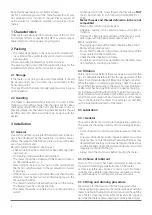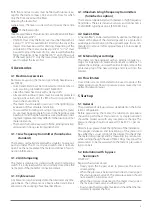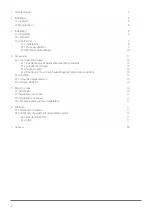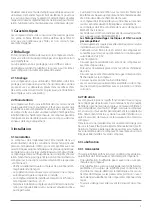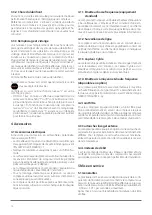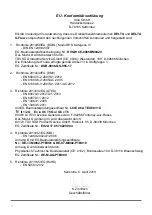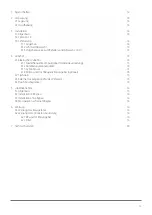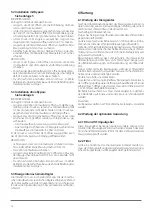
5
Both front and rear covers must be filled with lubricant, ex-
cept for the Delta Compact, SE, Evo and S1-Flow for which
only the front cover must be filled .
Adjusting the level of oil:
General case: The level is correct when it passes the centre
of the lowest sight .
Steel-bodied meters: The lubricant must be filled until it flows
out of the level point “L”
• DN50 S1-Flow: Only the front cover must be filled with oil .
4 plugs “F” or “D” are available to Fill or Drain the cover; the
lowest one must be used for draining . Depending of the
orientation of the meter, one level point “L1” or “L2” must
be used to adjust the level of oil i .e . unscrewed before the
filling . The lubricant has to be filled in “F” until it flows out
of the level point “L”, only the lowest level point must be
used to adjust the level of oil .
4 Accessories
4.1 Electrical accessories
Remarks about using the meter in potentially hazardous ar-
eas (ATEX):
• Pulse transmitters must be connected to intrinsic safe cir-
cuits, according to EN 60079-0 and EN 60079-11 .
• Clean the meter head only with a damp cloth .
• All exposed aluminium parts must be suitably protected
(using paint, varnish, etc) if a film of rust is possible from
dust in the environment .
• The meter must be taken in account in the lightning risk
evaluation of the complete installation .
• Tools used for installing, removing or repairing the meter
on site must be appropriate for use in the hazardous area
bearing in mind that the hazardous area classification dur-
ing meter replacement may differ from that during normal
meter operations .
• The meter shall not be exposed to flame, ionising radiation,
ultrasound or strong electromagnetic field .
4.1.1 Low frequency transmitter (furnished as
standard)
The meter is normally delivered with a double LF pulse out-
put transmitter . The LF is a dry reed switch and is normally
open . See the name plate of the meter and Annex 4 for con-
nection information .
4.1.2 Anti tampering
The meter is delivered as standard with an anti tampering
switch . It is a dry reed switch and is normally closed . See the
name plate of the meter for connection details .
4.1.3 Cyble sensor
A Cyble sensor can be installed onto the totaliser at any time,
see Annex 4 . The Cyble sensor is a bounce-free transmitter . It
allows also the counting of eventual back flows .
4.1.4 Medium & high frequency transmitters
(furnished as option)
The meter can be delivered with medium or high frequency
transmitters . There are inductive sensors, and connection is
to a NAMUR- type input circuit (EN 60947-5-6) .
4.2 Gasket-Filter
A “Gasket-filter” can be inserted directly upstream of flanged
meters at the place of the standard gasket: it is a protection
against particles remaining in the upstream pipe . It is recom-
mended to remove it after approximately 4 to 8 weeks of
operation .
4.3 External dryer cartridge
The meter can be equipped with an external silicagel car-
tridge for installation in severe environment conditions . To
replace the cartridge, unscrew the old cartridge, remove the
protective plug of the new cartridge and screw it into the
totaliser .
4.4 Flow limiters
Flow limiters are recommended to be used to protect the
meter against over-flows or pressure pulses caused by not
perfect installation layout
5 Start-up
5.1 General
The procedure of start-up is always dependent on the instal-
lation configuration .
Before pressurising the meter, the lubrication procedure
should be performed . Pressurisation or depressurisation
should be carried out with very low pressure change . The
pressure change should not exceed 0 .3 bar/5 P .S .I . per sec-
ond .
After start-up, please check the tightness of the installation .
The proper installation and functioning of the meter can
be verified by a visual control of the totaliser (to check that
the meter runs properly) and by measuring its pressure loss
while running though the use of Pete’s Plugs may allow this
pressure loss to be measured while the meter is pressurised
(up to 20 bar) .
5.2 Installation with by-pass:
See Annex 5
START-UP:
Begin with all valves closed .
• Slowly open the by-pass valve to pressurise the down-
stream piping .
• When the pressure is balanced downstream, slowly open
the small upstream valve V1 . The pressure variation should
not exceed 0 .3 bar per second .
• When the pressure is balanced in the meter, slowly open
the main upstream valve and then close V1 .
• Slowly open the downstream valve and check that the me-
ter starts to register the flow .




